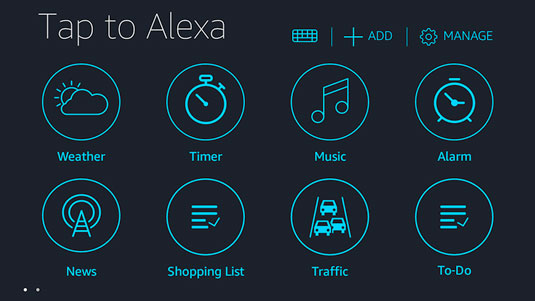Alexa and the Alexa app come with a few features that you can customize or enable to work around speech impairments:
- You can use the Alexa app to perform many Alexa tasks by tapping instead of speaking, including creating lists and adding items to lists, setting reminders, viewing contacts, creating smart-home routines, and adding skills.
- If you have trouble saying “Alexa,” you can try a different wake word.
- If you have an Alexa device with a screen, you can use the Tap to Alexa feature to issue Alexa commands by tapping instead of speaking.
- If you have an Alexa device with a screen, you can swipe down from the top of the screen and use the status bar to set alarms, create smart-home routines, and control smart-home devices.
- If you have an Alexa device with a screen, you can send text messages by tapping instead of speaking.
How to install a text-to-speech app for your Alexa device
One way to work around speech problems with Alexa is to use a text-to-speech (TTS) app on your smartphone or other mobile device. A TTS app lets you type some text, and the app then speaks that text for you through the device speaker. Here are a few popular (and free) TTS apps that are available for both iOS and Android:- Google Translate
- Talk For Me
- Text to Speech!
How to use Tap to Alexa
TTS apps enable you to interact with screenless Alexa devices such as the Echo, Echo Dot, and Echo Plus. However, if you have an Echo Show, you can use its screen to access a few common Alexa features with just a couple of taps on the screen. This feature is called Tap to Alexa, and currently it’s only available on the Echo Show. (Amazon says Tap to Alexa eventually will come to the Echo Spot in the future, so it may be available as you read this.)When you enable Tap to Alexa, you can tap the Echo Show Home screen to display a grid of icons — Amazon calls them tiles — that represent common Alexa tasks: getting the weather or news, setting a timer or alarm, playing music, or adding an item to your Shopping or To-Do list.
To get started, you first have to enable Tap to Alexa by following these steps:
- Swipe down from the top of the screen.
- Tap Settings.
- Tap Accessibility.
- Tap the Tap to Alexa switch to On.
 The default first page of the Tap to Alexa screen.
The default first page of the Tap to Alexa screen.What happens when you select a tile depends on the underlying task. Tapping the Weather tile is the same as saying, “Alexa, tell me the weather,” so you immediately hear Alexa giving you the current weather conditions and forecast. Similarly, tapping the Music tile is the same as saying, “Alexa, play some music,” so you hear a random playlist. Other tiles such as Traffic, News, and Joke also invoke Alexa immediately.
Some tiles represent tasks where Alexa requires more information from you. For example, tapping the Timer tile displays a screen that presents you with several options for the length of the timer. Similarly, tapping the Shopping List tile displays a screen that enables you to enter the item you want Alexa to add to the list.
The top-right corner of the Tap to Alexa screen is home to the following three icons:
- Keyboard: Displays an onscreen keyboard, which you can use to send any command you like to Alexa without having to use your voice.
- Add: Enables you to create your own Tap to Alexa tiles. When you tap Add, the onscreen keyboard appears, which you use to enter the command you want Alexa to carry out. You’re then prompted to select an icon and enter a label for the tile. When you’re done, your new tile appears in the Tap to Alexa screen (starting on the second page) using the icon and label you specified.
- Manage: Enables you to rearrange the Tap to Alexa tiles by dragging and dropping them. You can also delete a tile you don’t use by tapping the X that appears with the tile.
How to use Calling & Messaging Without Speech on Amazon Alexa
Alexa’s feature that enables you to speak a text message and have it sent to someone in your Contacts list is convenient and easy. Well, it’s convenient and easy if you can say the “Alexa, send a text” command and speak your message. If you can’t, are you out of luck? Nope, not if you have an Alexa device with a screen. The Echo Show and Echo Spot both support a feature that enables you to send texts (as well as place phone calls) by tapping the screen.First, follow these steps to enable the Calling & Messaging Without Speech feature:
- Swipe down from the top of the screen.
- Tap Settings.
- Tap Accessibility.
- Tap the Calling & Messaging Without Speech switch to On.
Here’s how to use Calling & Messaging to send a text by tapping the screen:
- Swipe down from the top of the screen.
- Tap the Communication icon (the speech bubble). The Calling & Messaging screen appears.
- Tap Contacts. Alexa displays a list of the contacts that are eligible for messaging.
- Tap the person to whom you want to send your message.
- Tap the Keyboard icon. Alexa displays an onscreen keyboard.
- Tap your message.
- Tap the checkmark. Alexa sends your message.




